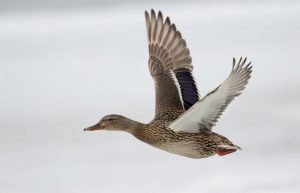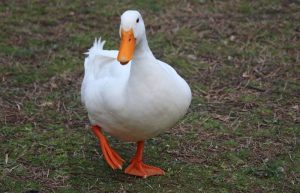
What You Need to Know About Ducks Flying
You’re more than likely familiar with the fact that ducks can swim and walk on land. They often reside near areas close to freshwaters like rivers, ponds, and lakes. However, you may be wondering how these birds do in the air.
Can ducks fly? Yes! Ducks are competent flyers who have been recorded traveling up to 20,000 feet in the air. The intricacies of their flight depend on their particular breed and purpose for being raised, but almost all ducks are naturally capable of flying as a means to migrate south during the colder months.
In this article, I’ll go over everything you need to know about duck flight, including the physics of how they fly, how the individual breed affects their flight capabilities, and some fun facts concerning the logistics of duck flight. Let’s get into it!
Duck Flight: How It Works
Four parts of a duck’s body are essential to flight: the primary feathers, secondary feathers, tail feathers, and winglets. Each of these parts serves a different purpose in the action of flying.
Primary Feathers
Primary feathers are long and stiff, typically found to be the furthest away from the duck’s body. Each duck has ten primary wing feathers to assist them in flying. These are also the feathers you clip to prevent flight. When a duck’s wing flaps downwards, called a downbeat, the primary feathers provide thrust to keep the body lifted. When the wings move upwards on the upbeat, the primary feathers provide room for air passage to travel to the secondary feathers.
Secondary Feathers
The secondary feathers are closer to the duck’s body. For reference, these are the colorful feathers you often see on male ducks’ wings. These feathers provide lift by forcing the air up from the wings.
Tail Feathers and Winglets
Though essential to flight control, tail feathers and winglets play less of a role in the motion of flying than primary and secondary feathers do. Tail feathers act as a “rudder” for the duck, helping them control their flight direction. Winglets, which are little feathers close to the duck’s body, help slow the duck down upon landing to ensure a smooth transition from air to ground.
How Long Can Ducks Fly?
Ducks use flight as their primary method of transportation when migrating south for the winter, but flying can be physically exhausting for these birds. Their wings are relatively short compared to their body, which means they are not efficient “soarers” like hawks or eagles. Instead, they have to flap their wings very fast at a rate of about ten flaps per second! This is a lot of effort to stay afloat in the sky, so ducks have to take frequent breaks when traveling long distances.
The breed of duck also impacts their ability to travel long distances. For example, the Black Brant species of duck can travel about 3,000 miles in 60-72 hours. Usually, these birds complete their journeys in a straight shot, meaning they don’t stop for breaks or rest. This causes them to lose up to half their body weight during migratory travels, which they need to make up for once they reach their destination.
On the other hand, Mallards are a more common type of duck and travel significantly less than Black Brants at once. Mallards can only travel about 800 miles in 8 hours. This tires them out immensely, and they have to rest for 3-7 days after this journey to regain their strength.
Individual birds may choose to migrate only a few hundred miles away or up to thousands of miles away, depending on how far north they are when they begin their journey.
How High Can Ducks Fly?
To migrate, the average duck flies at a height between 200 and 4,000 feet. This wide range depends on various factors, yet again, like the breed of the duck and where they are traveling to.
However, the highest recorded duck flight clocked in at about 20,000 feet. This height was noted when the duck accidentally flew into a traveling jet engine. Ducks are skillful flyers that can travel great distances both upwards and forwards during their migration season.
Different Breeds of Ducks and Their Flying Capabilities
Though there are over ninety species of ducks alive today, they can all be classified under one of three categories. There are diving ducks, dabbling ducks, and perching ducks. Each category of duck has slightly different flying styles and capacities. This article will focus on diving, dabbling, and domesticated ducks, as they each have various intricacies to their flying patterns.
Diving Ducks
Diving ducks, as you might have guessed from their name, are a type of duck that dives under the water to retrieve food. They are more adept at swimming and often dive deeper distances under the water to feed.
Because of this, their wings are shorter and fit more closely to their bodies than other species of duck. This means that they have less wing control, making it challenging to maneuver obstacles in the air. Diving ducks thrive when soaring over open water, like an ocean or lake, where there are not a lot of obstacles, and they have the option to switch from flying to swimming within a moment’s notice.
Diving ducks have to run across the water to pick up enough speed for their takeoff. Common breeds of diving ducks include the Black Scoter, Harlequin duck, and Barrow’s Goldeneye.
Dabbling Ducks
In contrast to diving ducks, dabbling ducks stay close to the water’s surface, often preferring shallow lakes and ponds to deeper, freshwater areas. These are the kind of ducks that you may see at the duckpond who tend just to dip their head under the water to find food or to clear their passageways.
Dabbling ducks spend more time on land than diving ducks, which means they are more susceptible to land predators. As a defense mechanism, they can take off in flight very quickly. Their long, broad wings allow them more control when flying to maneuver around obstacles with ease.
All ducks travel pretty quickly, at around 50mph. Regardless of wing shape or size, dabbling and diving ducks are incredibly efficient flyers with differing strengths and weaknesses.
Domesticated Ducks
 There are a variety of domesticated duck breeds. Some of these breeds can naturally fly while other breeds cannot. Heavier and larger domesticated duck breeds cannot lift themselves off the ground, making it near impossible for them to escape over a chicken-wire fence. One such breed is the Pekin Duck.
There are a variety of domesticated duck breeds. Some of these breeds can naturally fly while other breeds cannot. Heavier and larger domesticated duck breeds cannot lift themselves off the ground, making it near impossible for them to escape over a chicken-wire fence. One such breed is the Pekin Duck.
Pekin Ducks are one of the most popular duck breeds to raise for meat and eggs. These birds weigh anywhere from 8 – 12 lbs, categorizing them as a large duck breed. Their size makes it impossible for them to fly, which is why many farmers prefer this breed of duck to others.
How To Keep Domesticated Ducks From Flying Away
It’s no secret that people like to keep ducks as companions or raise them for their tender meat. Ducks can add a blast of personality to any farm with their comedic quacking and adorable appearance. However, domesticated ducks that can fly can easily escape and become more prone to predator attacks. So, how do you keep these ducks from flying away? Here are a few options to consider:
Wing Clipping
The practice of clipping a duck’s wings is controversial because some people believe it is cruel to take away a duck’s natural ability to fly. However, clipping is harmless and not permanent, as the duck’s feathers will molt off every season. This means it’s a process that has to be repeated every year to ensure the safety of your farm ducks.
To clip a duck’s wings, you simply trim a few of its primary feathers. These feathers provide the thrust that keeps the duck off the ground when flying; by clipping a few of the primary feathers, the duck cannot lift itself off of the ground by flapping its wings. The duck’s primary feathers are made of keratin, just like our fingernails and hair, so they won’t feel any pain during or after the clipping process.
Training
An easy, albeit less effective, way to prevent your ducks from flying is to use food as an incentive to keep them returning home. The easiest way to do this is to purchase ducks as babies or hatch them yourself. Once they are hatched, you can keep them in a covered pen to keep them from flying away.
Once they are older, you can use food and treats as an incentive to keep your ducks home. Simply feed them regularly, and they will learn to come back any time they want to eat.
It’s important to note that there are still risks associated with training, and the most effective way to prevent flight is by buying flightless ducks for your farm or clipping your ducks’ wings.
Invest in Flightless Ducks
There are many varieties of ducks that naturally cannot fly. These are typically the best choice for people raising ducks for meat or as pets. Some of these breeds include the Pekin, Magpie, and Cayuga species of duck. These are large ducks too heavy to fly, making them an excellent choice for backyard pets or the farmyard.
Poultry can be a great addition to your farm, providing self-sustaining avenues for food. I have many articles about the different types of poultry you can raise. Check out some of the articles below!
- How to Care For Guinea Fowl: Ultimate Guide For Beginners
- Difference Between Ducks and Geese: Ducks Vs. Goose Guide
- Do Chickens Get Cold? Essential Guide
